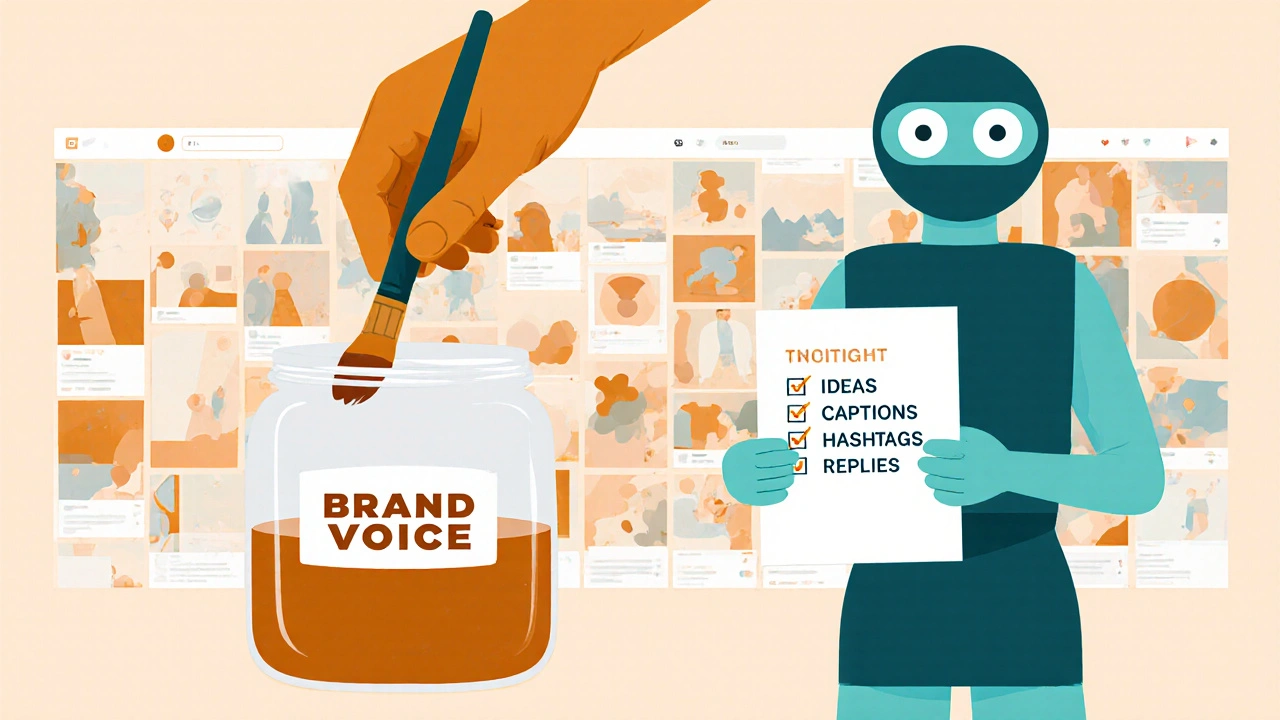ChatGPT: A New Approach to Instagram Marketing

Instagram isn’t just a photo app anymore. It’s a marketplace, a community hub, and a content factory-all rolled into one. But keeping up with daily posts, engaging comments, and trend-driven captions? That’s where most brands burn out. Enter ChatGPT. Not as a magic wand, but as a tireless assistant that helps you work smarter, not harder. If you’re still writing every caption by hand or guessing what hooks work, you’re leaving real growth on the table.
Why Instagram Marketing Needs a New Tool
Instagram’s algorithm favors consistency, relevance, and engagement. That means posting at least 4-5 times a week, replying to comments within hours, and using trending audio or hashtags before they peak. Most small teams can’t do this without hiring freelancers or burning out their in-house staff. Even big brands struggle. A 2024 survey by Sprout Social found that 68% of marketers said content fatigue was their biggest challenge. The problem isn’t creativity-it’s capacity.
ChatGPT doesn’t replace your voice. It amplifies it. Think of it like having a copywriter who knows your brand tone, never sleeps, and can generate 50 caption variations in 90 seconds. You pick the best one, tweak it, and post. Done.
How ChatGPT Actually Works for Instagram
Here’s the real breakdown: ChatGPT handles the heavy lifting so you can focus on strategy.
- Content ideation: Feed it your niche-say, “organic skincare for sensitive skin”-and ask for 10 post ideas based on current trends. It pulls from what’s trending on Reels, Stories, and carousels right now.
- Caption writing: Give it your brand voice: “friendly, no jargon, a little sassy.” Then ask for a caption for a new moisturizer launch. It gives you three options: one playful, one educational, one UGC-style.
- Hashtag strategy: Instead of copying popular tags, ask for 15 niche-specific hashtags with low competition but high engagement. It’ll suggest things like #SensitiveSkinRoutine or #CleanBeautyWithoutTheHype instead of just #skincare.
- Comment replies: Paste a common comment like “Where did you buy this?” and ask for 5 short, on-brand responses. You can save these as templates and use them in seconds.
- Reel scripts: Need a 15-second hook for a before-and-after video? Ask ChatGPT to write a script that starts with a question, builds tension, and ends with a CTA. It even suggests background music styles based on your audience’s age group.
One beauty brand in Austin used this exact method. They went from 3 posts a week to 7, increased engagement by 41%, and cut content creation time by 60%. They didn’t hire anyone. They just started using ChatGPT like a co-founder.
What Not to Do (The Common Mistakes)
ChatGPT isn’t perfect. And if you treat it like a fully autonomous system, you’ll get bland, robotic content that turns followers off.
- Don’t copy-paste. Every caption it writes starts as a template. You need to add your personality. A line like “This product changed my life” feels fake unless you add a tiny detail: “I cried the first time I used it-my eczema finally calmed down.”
- Don’t ignore visuals. ChatGPT can’t design graphics. But it can describe them. Ask: “Write a prompt for Midjourney to generate a flat-lay of our new serum with natural ingredients, soft lighting, and a linen background.” Then send that to your designer.
- Don’t forget the audience. If your followers are mostly moms over 40, don’t let ChatGPT write slang-heavy captions. Always edit for tone. Ask: “Rewrite this for a 45-year-old woman who values honesty over hype.”
- Don’t skip analytics. Use Instagram Insights to track which captions got the most saves and shares. Then feed those top performers back into ChatGPT: “Analyze this caption. Why do you think it performed well? Write 3 more like it.”

Real Example: From Zero to 10K Followers in 90 Days
A small yoga studio in Portland had 1,200 followers. Their posts were beautiful-but inconsistent. They posted once a week. Engagement was low.
They started using ChatGPT like this:
- Every Monday, they asked: “What are the top 5 yoga trends on Instagram this week?”
- They picked one trend-say, “morning stretch routines”-and asked for 5 Reel scripts.
- They filmed one Reel a day using the script, added trending audio, and posted at 7 AM.
- They used ChatGPT to draft replies to comments like “How long should I hold this pose?” with answers tailored to beginners.
- They asked for 10 niche hashtags like #YogaForBusyMoms or #HomeYogaWithoutEquipment.
Within 90 days, they hit 10,000 followers. Not because they went viral. But because they showed up every day with content that felt personal, timely, and useful.
How to Start Today (Simple Step-by-Step)
You don’t need to overhaul your whole strategy. Just start small.
- Choose one task. Pick the thing you hate most: writing captions? Coming up with ideas? Replying to DMs?
- Write a prompt. Example: “I run a small coffee shop in Boston. My audience loves latte art and weekend vibes. Write 5 Instagram caption ideas for a photo of our new cinnamon latte, using casual, warm language.”
- Test it. Post one of those captions. Track likes, saves, and shares.
- Refine. If it did well, ask ChatGPT: “Make 5 more like this one.” If it flopped, ask: “Why didn’t this work? How can I make it more relatable?”
- Scale. Once you’ve got one winning formula, apply it to your next post. Then the next.
That’s it. No apps. No subscriptions. Just you, your brand, and a tool that learns from your feedback.

ChatGPT vs. Human Copywriters: The Real Difference
Some say AI can’t match a human. That’s true-if you’re asking it to write poetry. But Instagram isn’t poetry. It’s quick, punchy, and repetitive. And that’s where AI shines.
Humans bring emotion, story, and cultural nuance. AI brings speed, scale, and consistency. You don’t need to choose one. You need both.
Use ChatGPT to generate 10 options. Then pick the one that makes you smile. That’s your brand voice. That’s your edge.
What’s Next? The Future of AI on Instagram
By 2026, Instagram will likely roll out AI-powered tools that auto-suggest captions based on your photo. But here’s the catch: those tools won’t know your brand like you do. That’s your advantage.
Right now, you’re ahead of the curve. Most businesses are still using stock captions or posting only when they have time. You’re using AI to stay consistent, relevant, and human. That’s not just smart-it’s sustainable.
The goal isn’t to replace yourself. It’s to free up space-so you can focus on what matters: building real relationships with your audience.
Can ChatGPT write Instagram captions that sound human?
Yes, but only if you edit them. ChatGPT writes in patterns. To make it sound human, add personal details, slang, or emotional hooks. For example, change “This product is great” to “I used this for three weeks and my skin finally stopped breaking out-I didn’t think it would work, but wow.” That tiny shift makes it feel real.
Is using ChatGPT for Instagram against Instagram’s rules?
No. Instagram doesn’t ban AI-generated content. In fact, Meta has been testing AI tools for creators. What matters is transparency and value. If your posts are helpful, consistent, and authentic-even if AI helped write them-they’ll perform well. Just don’t pretend the AI wrote it all by itself.
Do I need to pay for ChatGPT to use it for Instagram?
You can start with the free version, but the paid version (ChatGPT Plus) is worth it for marketers. It’s faster, handles longer prompts better, and doesn’t cut off mid-sentence. For someone posting 5 times a week, the $20/month fee pays for itself in saved time and higher engagement.
How do I train ChatGPT to understand my brand voice?
Give it examples. Paste 3 of your best-performing captions and say: “This is my tone. Write 5 more like this.” Over time, it learns your rhythm-whether you’re funny, serious, sarcastic, or soothing. Keep feeding it feedback. “This one’s too formal.” “This one’s perfect.” It gets better with every edit.
Can ChatGPT help with Instagram Stories and Reels too?
Absolutely. For Stories, ask for quick text overlays: “Write 5 punchy one-liners for a Story promoting our new sale.” For Reels, ask for scripts: “Write a 15-second Reel script that starts with a problem, shows the solution, and ends with a CTA.” It even suggests trending sounds based on your niche.
What if ChatGPT suggests hashtags that aren’t working?
Check Instagram’s search bar. Type in the hashtag and see how many posts are under it. If it’s over 500K, it’s too broad. Look for ones between 10K-100K-that’s the sweet spot. Then ask ChatGPT: “Find 5 more hashtags with 20K-80K posts in the beauty niche.” It’ll adjust.
Final Thought: You’re Not Replacing Creativity. You’re Protecting It.
The most successful Instagram accounts aren’t the ones with the most followers. They’re the ones that show up every day without burning out. ChatGPT doesn’t steal your creativity-it gives you back the time to be creative when it matters most. Whether you’re a solopreneur, a small business, or a growing brand, this isn’t about automation. It’s about sustainability.
Start small. Stay consistent. Let AI handle the grind. You handle the heart.



